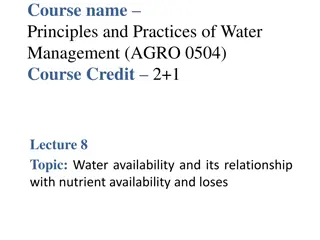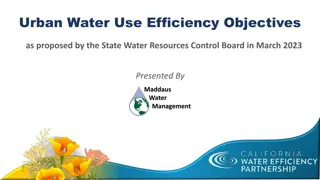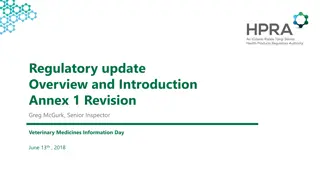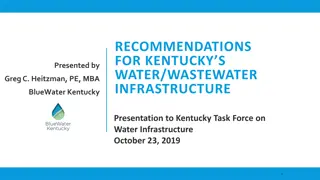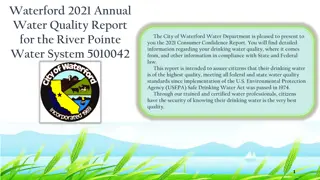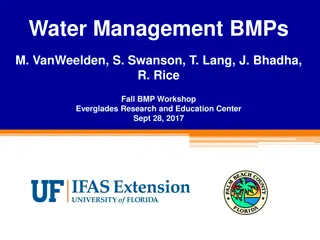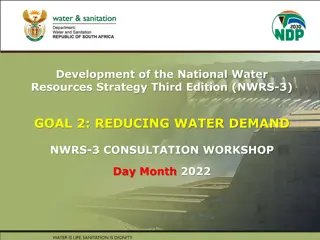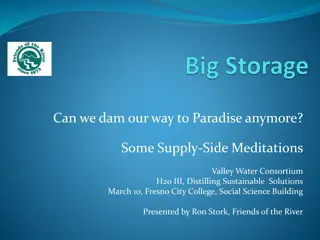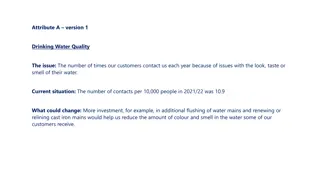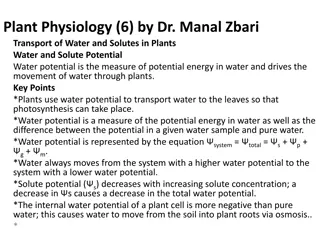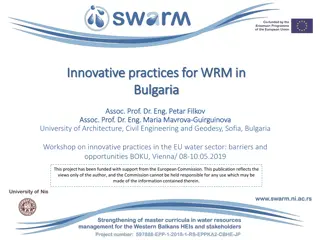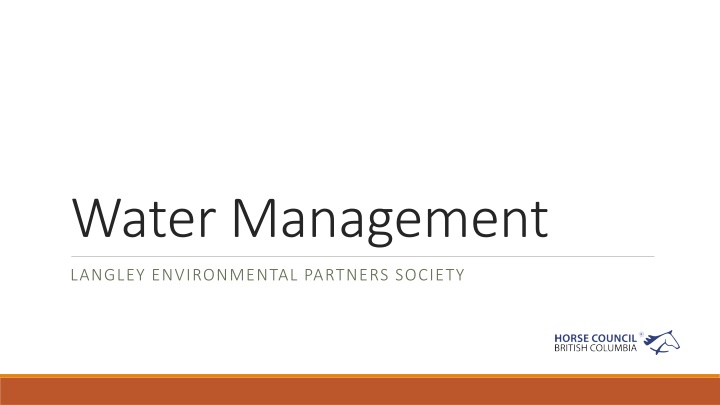
Sustainable Water Management Practices for Environmental Protection
Discover the essential guidelines for maintaining clean drinking water for yourself and your animals. Learn about the importance of managing manure piles and avoiding pollutants to prevent water pollution. Understand the concept of watersheds and how your property management practices can impact water quality in the surrounding environment.
Download Presentation

Please find below an Image/Link to download the presentation.
The content on the website is provided AS IS for your information and personal use only. It may not be sold, licensed, or shared on other websites without obtaining consent from the author. If you encounter any issues during the download, it is possible that the publisher has removed the file from their server.
You are allowed to download the files provided on this website for personal or commercial use, subject to the condition that they are used lawfully. All files are the property of their respective owners.
The content on the website is provided AS IS for your information and personal use only. It may not be sold, licensed, or shared on other websites without obtaining consent from the author.
E N D
Presentation Transcript
Water Management LANGLEY ENVIRONMENTAL PARTNERS SOCIETY
Water Management Andrea Lawseth Langley Environmental Partners Society Taken from the Land Management Guide for Horse Owners and Small Lot Farmers. Available from Horse Council BC.
Water Management It is vital you maintain clean drinking water for yourself and your horses by keeping manure piles and any chemical substances a safe distance from wells and domestic water sources. Potential pollutants include nitrogen, chemicals and bacteria, which can come from animal manure or chemical sources. Keeping animals out of streams, locating manure piles at a safe distance, and properly storing agrochemicals will help prevent any pollution problems.
Water Management Keeping streams and drainage ditches clean will help sustain habitat for fish and aquatic organisms. When managing our animals we need to take into account surface water including: creeks ditches streams swamps wetlands groundwater
The Watershed What is a Watershed? 1. An area of land that catches rain and snow and drains it into waterways. 2. Is defined by the height of the land and the surrounding topography.
The Watershed Collected water is received as precipitation which drains or seeps into surface water or groundwater which flows into nearby rivers and out into the ocean or lake.
The Watershed Even if your property is not located near a stream or lake your management practices can still have an effect on water quality through groundwater or drainage ditches; thus it is your responsibility to manage the quality of the water that leaves your property. 1. Manure creates excess nitrogen can cause algal blooms and the growth of aquatic vegetation, which use up oxygen as they decompose. 2. Fish and other aquatic organisms breathe dissolved oxygen and require it to survive
The Watershed Excess nitrates leaching into groundwater can cause health problems for humans as well, such as blue baby syndrome, cancer and other birth defects. Identifying where the watercourses run in your watershed will help you to make appropriate water management decisions.
Riparian Management What is a riparian area? 1. Refers to the land immediately surrounding or adjacent to a waterway or other source of water. 2. Should contain a diversity of indigenous trees and shrubs.
Riparian Management Vegetated riparian areas support a very high level of biodiversity and are highly susceptible to trampling by horses and cattle. They serve many important functions including: 1. Windbreak 2. Wildlife corridors 3. Shade and protection 4. Nesting habitats 5. Filtration for runoff 6. Provides food supplies
Riparian Management How do I manage my riparian area? Signs that indicate damage to riparian areas: 1. Reduction in the number of saplings and the reduction in plant height 2. Pugging (hoof tracks left in the soft soil) or hummocking (soil that has been pushed up by pugging due to trampling near the watercourse) Manure or urine in watercourses could lead to riparian area damage
Riparian Management To eliminate detrimental impact on riparian habitat: 1. Use alternative water sources to reduce trampling of vegetation and pugging of soil. 2. Provide salt, mineral and supplemental feeds away from the riparian areas to reduce the risk of water contamination. 3. Fence off the riparian area completely to provide a vegetative buffer for pasture run off.
Riparian Management Avoid soil erosion by: 1. Use of buffer strips to protect land if the area is prone to flooding. 2. Providing limited access points with better footing (ie: gravel) 3. Providing shade (ie: a roofed shelter or treed area) beyond the riparian zone to draw livestock away from the sensitive areas.
Riparian Management Four good reasons to restrict livestock access to riparian areas: 1. Prevents drowning during periods of high flow 2. Prevents foot rot to less loitering in muddy streams 3. Maintains healthy water quality for aquatic organisms and livestock 4. Prevents erosion by protecting stream banks from pugging
Livestock Management What type of watering systems are available? 1. Solar powered pumps 2. Sling pumps 3. Water Harvesting Systems 4. Gravity fed pumps 5. Nose pumps
Livestock Management Solar Powered Pumps 1. Use photovoltaic solar panels as a source of energy 2. Solar panels convert sunlight to DC electricity, which operates the pump and delivers water to livestock watering systems. Sling Pumps (or Flow of Stream pumps) 1. Use water current as a source of energy 2. Continuous pumping action during 24 hour period compensates for slow flow rates. Water storage may be required to meet the full needs at certain times throughout the year.
Livestock Management Water Harvesting Systems 1. Use stored rainwater as a source of energy 2. Utilizes storm water runoff. Must be filtered to meet drinking water standards. Gravity-Fed Pumps (or flow through livestock waters) 1. Uses gravity-pressured water supply as a source of energy 2. Constant flow of water prevents the formation of ice. Can be some water waste. Water should be stopped when not required by animals and outflow contained.
Livestock Management Nose Pumps 1. Uses a diaphragm pump as a source of energy 2. Animal pushes a lever with its nose and delivers about one liter of water 3. Water can be lifted up to 8 meters. One pump can provide water for up to 30 horses. Fully enclosed, which prevents pollution, ice formation and disease transmission.
Livestock Management 1. Locate the watering system at least 30m away from watercourses and wells 2. Situate the system away from feeding areas to encourage manure distribution 3. Provide a firm base (concrete or rubber mats) around watering area to prevent muddy soil conditions 4. Ensure adequate drainage for spillage and overflow 5. Check system for leaks regularly and other mechanical performance
Livestock Management How should water be managed in a confined livestock area? 1. Confined livestock areas include feedlots, paddocks, corrals, exercise yards and holding areas. 2. Regulations state that these must be at least 30m from the high water mark from any watercourse or wetland. Livestock may not have access to any natural watercourses or riparian areas. 3. Any contaminated runoff from a confined livestock area must be contained and managed as manure.
Livestock Management How should water be managed in a seasonal feeding area? 1. Seasonal feeding areas are locations that support livestock feeding operations for part of the year and may produce a crop. 2. Livestock waterers are encouraged in these regions.
Livestock Management How can I feed our animals to limit water pollution? 1. Controlled grazing in riparian zones can prevent streambank damage in wet weather and maintain vegetation. 2. Locating feeding sites where the ground slopes away from the watercourse and at least 30m from waterways and wetlands will further prevent damage. 3. Move livestock feed and supplements around the pasture to evenly distribute manure and reduce loitering near streambanks.
Livestock Management Four good reasons to keep manure out of water: 1. Prevents the spread of pathogens to other livestock, farms and people. 2. Prevents water contamination and unpalatable water sources. 3. Prevents algal growth, which depletes the water of oxygen. 4. Prevents ammonia contamination in watercourses.
Storm Water Management Why should I manage my storm water? 1. Storm water management is important in areas with high rainfall as barn, house and other building roofs can collect large amounts of muddy water that can run off to the ground. 2. One inch of rain on a 20ft by 50ft barn roof can produce up to 2347 liters of water, which is the equivalent to one and a half average-sized hot tubs.
Storm Water Management Mud can cause a multitude of health problems such as foot rot and thrush. This water should be directed away from high use areas in order to reduce mud. Plastic pipes can be used to direct water away from animal confinement areas to places that are more easily drained.
Storm Water Management When land drainage is a serious concern, drainage management features can be installed, such as French drain lines or drainage tiles. Grassed waterways, water bars, ditches and dry wells can also be created to prevent water pooling. Planting native trees and shrubs or other water-loving species, such as willow, cottonwood and red osier dogwood can help to soak up some of the water runoff and prevent siltation and contamination of nearby watercourses.
Ground Water Protection Why Should I protect groundwater? 1. Groundwater refers to the water that infiltrates through the ground and accumulates in the underground bodies called aquifers 2. Groundwater can resurface in wetlands and floodplains as springs and percolate into streams to be pumped by wells to the surface 3. Many landowners depend on this water for drinking purposes so it is important to ensure that it remains clean
Groundwater Protection To safeguard groundwater against pollution there are a number of ways you can protect it. 1. Determine where your well is in relation to your manure pile, grazing areas, drainfield, etc 2. Keep Livestock away from the wellhead heavy animals can damage the drainfield by compacting soils and damaging buried pips 3. Divert surface water away from the wellhead
Groundwater Protection Locate your manure pile at least 30 m away and downhill from the wellhead 1. Test well water annually for fecal coliform bacteria and nitrates. 2. Avoid leaving hoses immersed in contaminated stock tanks to prevent backflow. 3. Fence off the septic field area to avoid the spread of diseases by grazing livestock
Soil Erosion Control How do I control soil erosion? 1. Soil erosion is a serious concern in all areas of the Province. Whether you live in wet climate that suffers from soil runoff or a dry climate where wind dispersal is a concern, soil loss is an issue we all need to deal with. 2. Soil can sluff into watercourses and cause siltation problems. Sild can cloud the water so that fish are unable to see food sources, smother trout and salmon eggs and cover spawning habitat.
Soil Erosion Control 1. Minimize these effects of soil erosion through the use of buffer strips, shelterbelts or hedgerows. 2. All of these buffers that are planted at the edge of the pasture to reduce the risk of wind or water runoff.
Soil Erosion Control 1. Buffers can also provide potential income if saleable crops such as raspberries or fruit trees are planted 2. If you are looking for aesthetic benefit then grasses, flowering shrubs and trees, floral plants and ornamental plants can also be planted 3. The width of the buffer zone will be dependent on the slope of the field, the soil type and the density of the species you choose to plant
Soil Erosion Control Some of the advantages of a buffer zone include: 1. Filters mud, manure, pesticides and bacteria out of water flowing across or through the air 2. Improves infiltration of water into the soil 3. Provides food and cover for wildlife 4. Protects land from erosion caused by water and wind 5. Creates an attractive landscape 6. Can save on fence installation and repair
Chemical Handling and Storage Manure and agrochemicals are not the only pollutants present on small farms. Animal medical waste and petroleum products are often prevalent and ignored when it comes to land management.
Chemical Handling and Storage 1. Animal medical waste must be disposed of in a responsible and safe manner 2. Grind them down or destroy syringes and needles to eliminate chances of puncture, then package and pack the sharps in a rigid container 3. Both needles and syringes should also be boiled for 5 minutes or soaked in disinfectant before disposal
Chemical Handling and Storage 1. Other medical supplies, medicine bottles and old medication should be taken back to the supplier or pharmacy for disposal as these can have serious consequences on aquatic organisms if they are allowed in the sewage waste system. 2. Used medication should never be added to your manure or compost piles
Chemical Handling and Storage How do I safely use and dispose of petroleum products? Fuel tanks should be maintained to avoid any pollution to the surrounding environment. 1. Tanks should be equipped with anti-siphoning devices included in discharge unless there is already a self-closing nozzle 2. Drains must be lockable and in a closed position at all times if not being used 3. Drips, leaks and over flow should always be avoided when dispensing fuel and care should be taken when filling the tank to prevent any overflow
Chemical Handling and Storage 1. Storage tanks must be built with accepted engineering practices and may include a concrete, diked storage area 2. Tanks must be located away from yard drains and set back at least 30m from any watercourse or ditch 3. Tanks should be well protected from direct collision by farm vehicles 4. When disposing, all excess petroleum products should be brought to an appropriate hazardous waste facility in your area
Congratulations! You have completed the Water Management Online Course To purchase the Land Management Guide for Horse Owners and Small lot farmers Visit the HCBC bookstore at www.hcbc.ca




